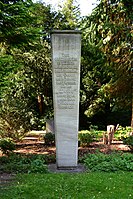Wave (ship, 1916)
|
Cenotaph at the Nordfriedhof Kiel
|
||||||||||||||||||||||
|
||||||||||||||||||||||
|
||||||||||||||||||||||
|
||||||||||||||||||||||
The wave was a so-called test boat of the German Reichs and Kriegsmarine , which capsized in a heavy snowstorm in the Baltic Sea in January 1937 and went down with all of its crew .
history
The ship was originally a German fish steamer , which entered service on November 10, 1916 under the name of von der Goltz . During the First World War it served first in the auxiliary minesweeping flotilla in the North Sea and from February 12, 1918 in the IV minesweeping flotilla . After the end of the war, the ship came to Great Britain in 1921 as reparations and sailed there from 1922 to 1924 under the name Star of Eve . Then it was sold back to Germany, where the Reichsmarine used it as a test boat at their intelligence research institute after a corresponding conversion with the name Grille from 1927 . There the ship was used to test the radio measuring devices under development .
The use of the grille was particularly helpful in the development and testing of the new sonar method for locating submarines and ships . The experiments were directed by Rudolf Kühnhold from the Reichsmarine's intelligence research institute in Kiel . For these purposes, the predecessor company of the Society for Electroacoustic and Mechanical Apparatus (GEMA) , which is entrusted with other tasks today, was founded in early 1934 . From land, the cricket could be seen at a distance of eight to twelve kilometers.
Since the state yacht Grille, launched in December 1934 , was to be given the traditional name Grille , the test boat was renamed Welle in 1934.
Downfall
On the night of January 18 to 19, 1937, the ship tried to rescue the crews of the schooner Duhnen , which was stranded in a heavy snowstorm near Fehmarn, and the salvage tug Fairplay 10, which was also stranded . Here capsized the shaft due to the freezing of their bodies and the heavy seas and sank with its entire crew of 25 men west of Fehmarn. Four of the dead were buried in the north cemetery in Kiel, twelve were transferred to their homeland. The other nine stayed with their ship on the seabed. The ship was lifted on February 15, 1937 and deleted from the list of ships of the Kriegsmarine on March 12, 1937. Further fate - whether it was scrapped or sold and rebuilt - is unknown.
In the Naval Memorial Laboe , a wooden plaque in the tower of the memorial commemorates the crew members of the boat, and there is a memorial for them in the Kiel North Cemetery .
Web links
- https://www.kiel.de/de/umwelt_verkehr/friedhoefe/_$historische_graeber/marine/welle.php
- http://www.denkmalprojekt.org/dkm_deutschland/laboe_welle_1937_sh.htm
Individual evidence
- ↑ Radio Fairs in Germany - The Development 1933-35 ( Memento of the original from February 15, 2013 in the Internet Archive ) Info: The archive link was inserted automatically and has not yet been checked. Please check the original and archive link according to the instructions and then remove this notice.
- ↑ http://www.geschichtsspuren.de/artikel/29-luftverteidigung/64-entwicklung-der-funkmesstechnik.html
